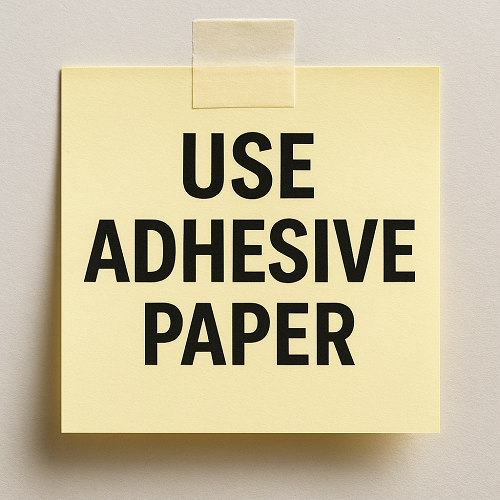Adhesive paper—commonly known as sticker paper or self-adhesive label stock—is one of the most widely used yet technologically complex materials in the packaging, logistics, and printing industries. Though it seems simple, adhesive paper integrates multiple layers of chemistry, material science, and precision manufacturing to achieve consistent performance across diverse environmental and application conditions.
Structure and Composition of Adhesive Paper
Adhesive paper is a multilayered composite typically consisting of three fundamental components:
Face Material (Top Layer):
The printable surface, which can be paper, synthetic film, or a specialty substrate.
- Paper-based: Often made from wood pulp, clay-coated paper, or thermal paper. Common for office labels and product packaging.
- Film-based: Includes polyethylene (PE), polypropylene (PP), polyester (PET), or vinyl for durability, waterproofing, and flexibility.
- Specialty materials: Metallic foils, fabric, or eco-friendly biofilms.
Adhesive Layer (Middle Layer):
This layer determines how the label bonds to the target surface.
The three main categories are:
- Permanent adhesives: Create a lasting bond (e.g., acrylic, rubber-based).
- Removable adhesives: Allow clean removal without residue.
- Repositionable adhesives: Offer temporary adhesion and reusability.
Release Liner (Bottom Layer):
- A silicone-coated backing that protects the adhesive until use. Typically made of glassine paper, polyethylene-coated paper, or polyester film.
Each layer is engineered for compatibility—balancing printability, adhesive strength, durability, and environmental resistance.
Manufacturing Process
The production of adhesive paper involves multiple stages of precision coating, lamination, and curing:
Adhesive Formulation:
Adhesive chemistry depends on the intended application.
- Acrylic adhesives (emulsion or solvent-based) offer UV resistance and stability.
- Rubber-based adhesives provide strong tack and quick bonding but degrade under heat or UV exposure.
- Hot-melt adhesives are 100% solid formulations applied in molten form for high-speed production.
Coating Process:
Adhesives are applied to the face stock or liner using methods such as:
- Meyer rod coating
- Gravure coating
- Slot die coating
- Curtain coating
Uniform coating thickness (usually 10–25 μm) is critical for consistent adhesion.
Drying and Curing:
- Solvent or water from the adhesive must be evaporated. This is achieved through convection ovens or UV-curing systems.
Lamination:
- The adhesive-coated substrate is laminated to the release liner under controlled pressure and tension.
Conversion:
- The laminated rolls are slit, die-cut, and sometimes pre-printed before being wound into finished rolls or sheets.
Technical Properties and Testing Standards
Adhesive paper must meet precise standards for print quality, adhesion, and durability.
Key tests include:
- Peel Adhesion (ASTM D3330): Measures the force required to peel the label from a surface.
- Shear Strength (ASTM D3654): Tests the cohesive strength of the adhesive.
- Tack (Initial Adhesion): Evaluates how quickly the adhesive bonds on contact.
- Environmental Resistance: Exposure to humidity, UV light, and temperature cycling to simulate real-world use.
- Printability Tests: Assess compatibility with inkjet, laser, thermal transfer, and flexographic printing systems.
Performance optimization often involves balancing contradictory requirements—such as strong adhesion versus easy removability, or high gloss versus print absorbency.
4. Technical Issues and Common Defects
Despite advances in coating and material science, adhesive paper manufacturing faces several technical challenges:
- Adhesive Bleeding: Migration of adhesive beyond die-cut edges, causing labels to stick together or jam printers. Usually due to excessive coating thickness or poor curing.
- Curling: Caused by uneven moisture content or tension imbalance between face stock and liner. This can distort label alignment during printing.
- Liner Breakage: Thin or brittle liners may tear under tension during high-speed dispensing.
- Poor Print Adhesion: Ink not bonding properly to coated or synthetic surfaces, often due to surface energy mismatch.
- Environmental Sensitivity: Temperature and humidity fluctuations can alter adhesive tack or cause delamination.
- Silicone Transfer Failure: Incomplete release coating leads to sticking issues between adhesive and liner.
Manufacturers employ precision coating lines with closed-loop control systems to monitor coating weight, web tension, and curing profiles to minimize such defects.
Innovations and Sustainability Trends
The adhesive paper industry is rapidly evolving toward sustainability, recyclability, and smart functionality:
- Recyclable label constructions: Development of water-dispersible adhesives and easily separable liners for paper recycling streams.
- Linerless labels: Eliminating the release liner entirely, reducing waste and material cost.
- Bio-based adhesives: Derived from natural polymers like starch or lignin.
- Smart labels: Integrating NFC, RFID, or QR codes for digital tracking.
- Low-migration adhesives: Designed for food-contact safety.
- UV-curable and solvent-free adhesives: Reducing VOC emissions during production.
These innovations aim to meet regulatory, environmental, and performance demands in industries like logistics, healthcare, food packaging, and e-commerce.
Applications Across Industries
Adhesive paper is ubiquitous across nearly every modern sector:
- Consumer Goods: Branding labels, barcodes, and tamper-evident seals.
- Logistics: Thermal labels for shipping, warehouse tracking, and inventory control.
- Pharmaceuticals: Security labels with batch traceability and chemical resistance.
- Automotive and Electronics: Durable film labels for high-temperature environments.
- Retail and Office Use: Stickers, name tags, and printable sheets for desktop printers.
Each application has unique requirements for adhesion, surface compatibility, print resolution, and resistance to environmental stress.
Future Outlook
The future of adhesive paper technology lies in precision customization and circular design. Artificial intelligence and digital printing integration will enable adaptive adhesive formulations and real-time quality control. Meanwhile, global regulations on plastic waste and recycling will drive material innovation—favoring recyclable paper backings, biodegradable films, and solvent-free coatings.
Adhesive paper, though often overlooked, embodies the intersection of chemical engineering, material science, and sustainable manufacturing. Its continued evolution will play a crucial role in shaping the future of smart packaging and environmentally responsible labeling.

